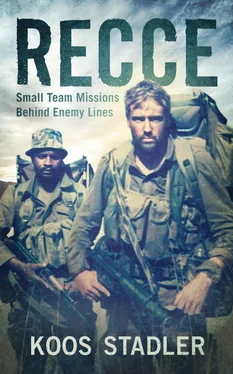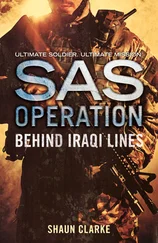I was still baffled. I thought they were about to abandon the missile system and take all the equipment away. I started to protest and tried to explain to the commander that I needed to stay with the SAM-9.
But my worry was short-lived. The Kwêvoël was driven to the front of the BRDM and parked about two vehicle lengths’ away. To my astonishment the shovel-bearing youngsters cleared a stretch of sand between the two vehicles and started digging. Throughout the rest of that day, they methodically sunk a pit in front of the BRDM, working rhythmically to a song they sang. Every now and again a fresh hand would jump in and grab a spade from one of the group. It was beautiful to watch – the harmony of the labour, the rhythm, the ease with which they accomplished a task that for most Westerners would have been impossible.
A trench sloped down from the Kwêvoël towards the BRDM, levelling out a few metres in front of it. By that afternoon the pit was deep enough for the Kwêvoël to reverse into, and for the BRDM to run forward onto the back of the Kwêvoël. Now they were faced with the challenge of how to get the unserviceable armoured car onto the back of the Kwêvoël. However, they also had this worked out. Two technical geeks started unwinding the winch from the BRDM’s front, looping the cable straight across the armoured hull of the Kwêvoël to where the Mercedes truck was waiting some distance away. With the cable fully extended and hooked onto the Mercedes, this became a simple operation. The Mercedes inched forward, pulling the BRDM slowly but steadily onto the Kwêvoël.
Once the BRDM was snugly on top, the next job was to get the Kwêvoël out of the pit. But even that turned out to be a minor challenge, as they simply let the Mercedes, with the winch cable still attached to the BRDM, move forward slowly, assisting the Kwêvoël with its massive load to get onto level ground.
We were ready to go, but as we started rolling I immediately saw that there was no way the huge combined structure of the two vehicles would pass under the tree canopy. But, again, I had underestimated the resolve and genius of these people of the bush. They simply placed two capable axe handlers on the Kwêvoël’s hardened roof. These guys patiently and methodically chopped away at any branch, whatever the size, that blocked the way. It took us two full days (and probably five times as many axe blades) to cover the distance to the base where the rest of the team was waiting. Disregarding the time and huge amount of effort it required, the UNITA soldiers literally cut a path out of the tree canopy for the BRDM to slide through.
But still our woes were not at an end. On the morning of the second day the Mercedes truck, my taxi, suddenly came to a halt with a flat rear tyre. We were stuck in the deep soft sand of the vehicle track. Then it transpired that there was no jack. With the vehicle fully loaded with bags of maize and all our equipment, and without proper tools to change the tyre, I assumed we were stuck for good.
Yet again I was proven wrong. Twenty young men jumped on the vehicle and offloaded every item, including all the bags of food. In the meantime, two of the axe-men started chopping down a Y-shaped tree with a trunk about a metre in diameter. Once the tree was down they cut off the two main branches, leaving a distinct and solid-looking Y-shaped part of the tree to serve as a base. While they took time cleaning away the smaller branches from one of the remaining poles, a few of the men dug a hole about two metres from the truck. In this they inserted the long end of the Y, burying it halfway so that the forked part was next to the vehicle.
Next came the tree trunk that had been stripped of branches. This was laid into the V-shaped base with the short end under the truck body. Bingo, we had a crude crowbar that proved to be amazingly effective. A group of UNITA soldiers got onto their comrades’ shoulders and, slowly and tentatively, started to hang on to the long end of the “crowbar”. Suddenly the Mercedes lifted, and with a loud shout everyone still standing around grabbed a piece of the tree trunk and held on as a few good men swiftly changed the wheel – in a matter of five minutes.
The whole tree-felling, jack-rigging and wheel-changing operation took no less than three hours. When we finally arrived at the UNITA main base, a team of Special Forces technicians had already been flown in by helicopter with a new gearbox for the BRDM. It took the tiffies a day and a night to lift the old gearbox out and fit the new one. Once they were done, the vehicle was as good as new.
Two days later we reached our target area, high ground overlooking the flood plain of the Gimbe River. That night Diedies deployed the two missile systems right in the open, about 40 m from the tree line. We cut branches from trees way into the bush line and camouflaged the two vehicles until they appeared to be clusters of loose-standing thickets. The Small Team guys and the missile operators dug in just inside the tree line, while Captain Mickey established his headquarters higher up on a dune sloping down to the river, close to our mini-HQ where the intelligence officer, the tiffies and the doctor were deployed. The UNITA company served as protection element and were deployed in a rough half-circle to our rear.
We hadn’t even properly set up our little camp when two “swing-wing” MiG-23s suddenly appeared from nowhere, flying almost at treetop level and generally just making a nuisance of themselves. I was frightened, lying dead still in my trench, expecting the pilots to see me at any moment. They kept on fooling around, one moment coming over slowly with the wings extended, then screaming down with wings pulled in and breaking the sound barrier. Later I heard that the UNITA soldiers wanted to open fire with their small arms, which would have given away our vulnerable position and ruined the operation. We were not armed for defence against fighter attack, and our mission was to shoot down a transport, not a fighter plane.
The very next day we heard the Antonovs flying over, sometimes directly over our positions. There were many flights, often as many as five or six a day. Over the next six weeks we recorded more than 140 flights. Unbelievably, over that whole period the missile operators were unable to get a single lock-on. The rainy season was approaching fast and the days were cloudy, making it impossible for the heat-seeking infrared systems to lock on to the engines of the aircraft.
I learned much from Neves Matias and CC Victorino during this operation. Right from the beginning they settled into a routine they diligently stuck to throughout the deployment. They took it upon themselves to organise the daily tasks of placing security details, collecting information from UNITA, camouflaging positions and sending patrols to fetch water from the Gimbe River. Every second day Victorino ensured that the missile systems were covered with fresh foliage and that the dry branches were removed and hidden under the tree canopy. He painstakingly effaced all the tracks that led to and from the missiles. I soon realised that these guys had been moulded by years of experience, and that the base routine was borne of a simple understanding of its importance.
After six weeks, we were ordered to withdraw. We had many scares that FAPLA had located our position and were on their way to intercept us with a large force or that they had identified our camp and were about to launch an air attack. However, aside from occasional random bombing by the MiGs in the area, we were never targeted. Diedies requested an extension, stating that we had not been discovered and needed two more weeks.
And so it happened that one morning, during the extension period, Christie Smit, the medical doctor, was leading the morning dedication. He read from Ephesians 3:20: “Now to Him that, through His grace working in us is able to do so much more than we can think of, or even pray for, to Him be the glory.”
Читать дальше












